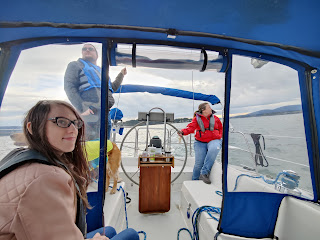We took the 320 out for a test sail from Cap Sante Marina in Anacortes. The dock we were on is tricky, as it is in a narrow channel that is affected by the tides and there were other boats on the parallel dock. Still, Sandi took her out smoothly. We got her out in the bay. After testing motoring for a bit, we noticed the transmission was not quite reacting the way we'd like, being stiff and not wanting to go into gear. We brought out the jib, and shut the motor off. On the first tack, the jib knocked one of the spreader boots off, which landed on deck. Our rigger had said they were old, but thought they'd last the season. The spreader boot acts as a cap on the end of the spreader that keeps the sail from getting snagged and ripping. It's kind of important to have.

|
| Underway for the first time since the sea trial |
We decided not to bring the main out, partly because we had the Dutchman system only partly connected. We still needed the backstay for that, which we had on order. The Dutchman is an interesting alternative to lazy jacks. There is a filament that is threaded through the sail that goes from the bottom to the back stay fastened from a halyard at the top of the mast to the end of the boom. The filament attaches at two places on the backstay. When the sail is dropped, it flakes itself on the filaments. This Dutchman was original to the boat, but the filaments were broken and the backstay was nowhere to be found on the boat. We had taken the sail into Doyle sails in Seattle. They replaced the filaments, as well as adding a second reefing point and replacing the slugs that hold the sail to the mast. Four of the slugs were broken when we bought the boat, but they all needed to be replaced.
After being out for a short time, Sandi expertly piloted her back into our dock.
In the next several days, our rigger, Kent Morrow of North Sound Rigging, went up the mast and replaced all of the spreader boots. He also replaced all of the lifelines that were at end of life.